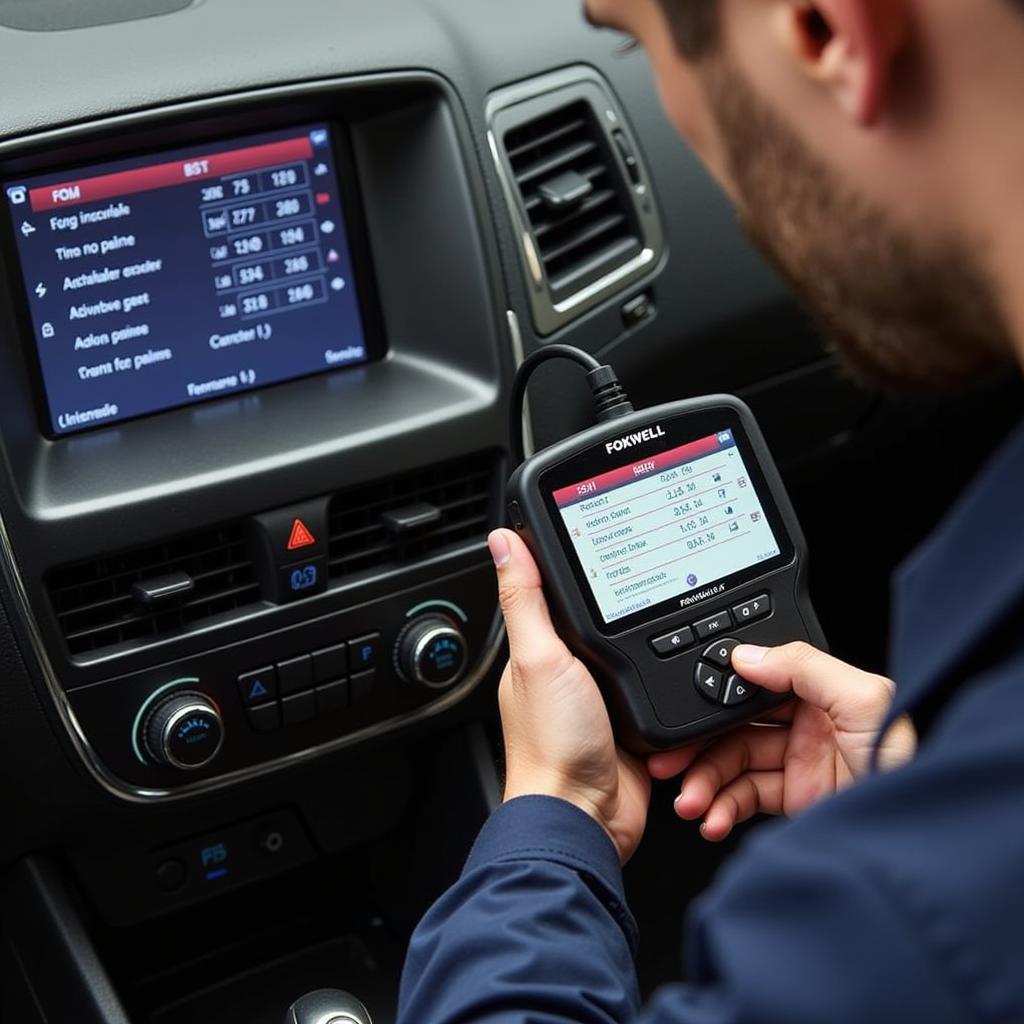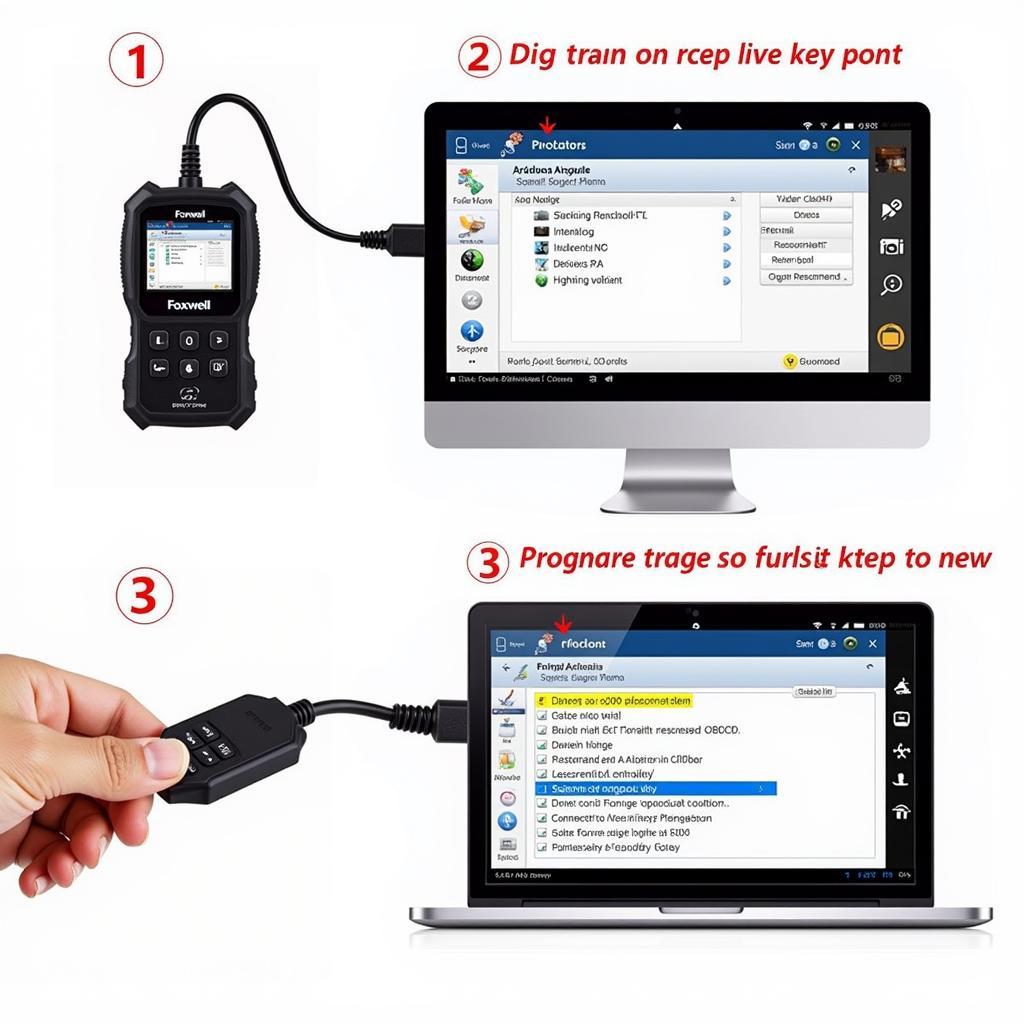The Foxwell BT705 battery tester is an essential tool for any car owner, mechanic, or automotive technician. It provides a comprehensive analysis of your car battery’s health, going beyond simply telling you if it’s dead or alive. But understanding what the test results actually mean can be tricky. This article will guide you through interpreting the meaning of battery test results from the Foxwell BT705, empowering you to make informed decisions about your car’s battery health.
Decoding the Data: What the Foxwell BT705 Measures
The Foxwell BT705 doesn’t just show random numbers; it measures key parameters that directly reflect your battery’s condition. These parameters include:
- Voltage: This indicates the electrical potential difference between the battery terminals. A fully charged battery typically shows around 12.6 volts.
- Cold Cranking Amps (CCA): This measures the battery’s ability to start your engine in cold weather. A lower CCA than the battery’s rating indicates a weakened battery.
- Internal Resistance (IR): This reflects the battery’s internal opposition to current flow. High internal resistance can point towards battery aging or damage.
- State of Health (SOH): This provides an overall percentage of the battery’s remaining capacity and health, offering a quick assessment of its condition.
Interpreting Your Foxwell BT705 Battery Test Results
Now that you know what the Foxwell BT705 measures, let’s dive into interpreting the results:
Voltage Readings: A Window into Charge Levels
- 12.6V or higher: This indicates a fully charged and healthy battery.
- 12.4V – 12.6V: Your battery has a good charge, but consider charging it soon.
- 12.0V – 12.4V: Your battery is partially discharged and needs charging.
- Below 12.0V: Your battery is deeply discharged and may require replacement.
Cold Cranking Amps (CCA): Assessing Starting Power
Compare the CCA reading on your Foxwell BT705 with the CCA rating printed on your battery.
- CCA reading close to the battery’s rating: Your battery has sufficient starting power.
- CCA reading significantly lower than the battery’s rating: Your battery is weak and may struggle to start the engine, especially in cold weather.
Internal Resistance (IR): Unveiling Hidden Issues
- Low internal resistance: Your battery is in good condition and allows efficient current flow.
- High internal resistance: This suggests internal damage or aging. The battery may need replacing, even if the voltage seems normal.
State of Health (SOH): The Big Picture
The SOH provides a straightforward assessment of your battery’s overall health:
- 80% – 100%: Your battery is in excellent condition.
- 60% – 80%: Your battery is in good condition but may require replacement soon.
- 40% – 60%: Your battery is nearing the end of its life.
- Below 40%: Your battery is at the end of its lifespan and needs immediate replacement.
Common Foxwell BT705 Battery Test Results Scenarios
Let’s consider some common scenarios:
-
Scenario 1: Your Foxwell BT705 shows a voltage of 12.2V, CCA of 450A (rated CCA is 500A), and SOH of 70%.
- Interpretation: Your battery is partially discharged and slightly weaker than its rated capacity, but it’s still in decent overall health. Consider charging it soon.
-
Scenario 2: Your Foxwell BT705 shows a voltage of 12.6V, CCA of 200A (rated CCA is 550A), and SOH of 45%.
- Interpretation: Although your battery appears fully charged, its CCA is significantly lower than its rating, indicating a severe loss of starting power. The low SOH further confirms that the battery is nearing the end of its life and requires immediate replacement.
Expert Insights:
“Don’t underestimate the importance of regular battery testing,” says Mark Stevenson, Senior Automotive Engineer at ScanToolUS. “The Foxwell BT705 allows you to proactively monitor your battery’s health and avoid unexpected breakdowns. Remember, a failing battery can lead to starting problems, electrical issues, and even leave you stranded.”
Conclusion: Empowering Informed Decisions with the Foxwell BT705
Understanding the meaning of your Foxwell BT705 battery test results is crucial for maintaining your vehicle’s reliability. By interpreting the voltage, CCA, internal resistance, and SOH readings, you can make informed decisions about charging or replacing your battery, ensuring optimal vehicle performance and avoiding potential inconveniences. For personalized support and expert guidance on battery testing and automotive diagnostics, contact ScanToolUS at +1 (641) 206-8880 or visit our office at 1615 S Laramie Ave, Cicero, IL 60804, USA.
Frequently Asked Questions
1. How often should I test my car battery with the Foxwell BT705?
It’s recommended to test your battery at least every three months, or more frequently if you live in an area with extreme temperatures.
2. Can I use the Foxwell BT705 to test different types of batteries?
Yes, the Foxwell BT705 is compatible with a wide range of 12V batteries, including standard flooded batteries, AGM batteries, and gel batteries.
3. What does it mean if the Foxwell BT705 shows “Bad Cell” during testing?
This indicates a faulty cell within the battery, rendering it unusable. A battery with a bad cell needs replacement.
4. Can I recondition a battery with a low SOH?
While some battery chargers offer reconditioning functions, their effectiveness varies. A low SOH often indicates permanent damage or aging, and replacement is usually the best solution.
5. Does the Foxwell BT705 require any special maintenance?
The Foxwell BT705 is a low-maintenance tool. Ensure you store it in a clean, dry environment and avoid dropping or exposing it to extreme temperatures.


